Traditional Panettone Recipe
This post may contain affiliate links. See my disclosure policy.
Soft, light, chewy, fruity and wonderfully fragrant, Panettone is Italy’s world famous sweet bread that is traditionally enjoyed for Christmas and New Year. But you don’t have to limit yourself, with this traditional Panettone recipe you can enjoy this scrumptious treat any time of year. And if you’re like me and have never cared for the store-bought stuff get ready to be converted because homemade is a total game changer!
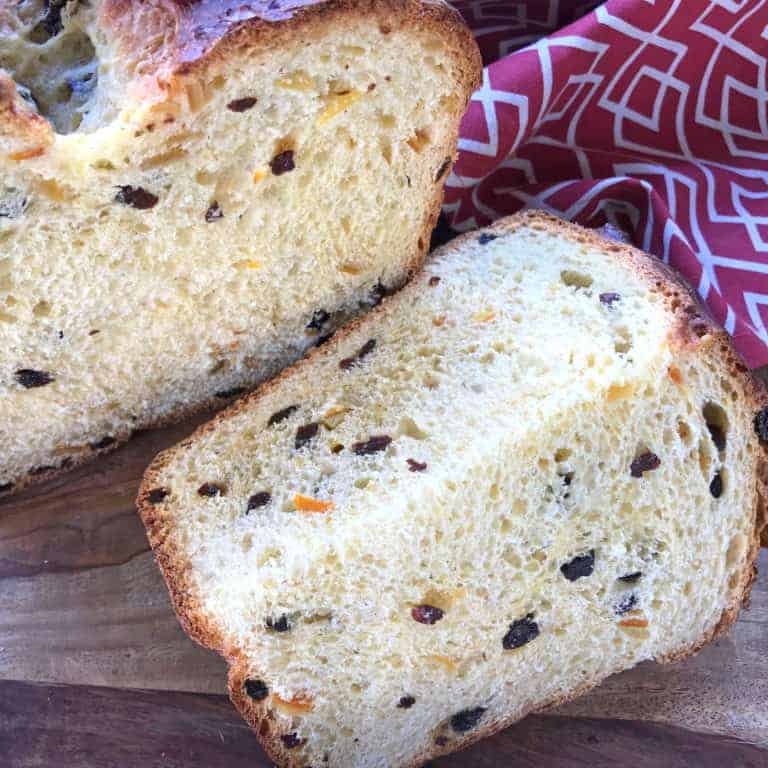
Panettone is synonymous with an Italian Christmas. Indeed, the two have gone hand in hand for centuries and to deviate from the tradition would be unthinkable. And so year after year Italian home bakers continue that tradition and for those who prefer the convenience of store-bought, Italian food manufacturers produce more than 7,100 tons of panettone each year – and only 10% of those are sold outside the country. With a population of 16.5 million people in Italy that averages out to nearly 4.5 pounds of panettone per person (adult, child and infant) per year. That’s A LOT of panettone!
What is Panettone?
Panettone is an Italian type of sweet bread loaf with sourdough-like properties usually prepared and enjoyed for Christmas and New Year’s. Panettone comes from the city of Milan in the Lombardy region of northern Italy. Milanese bakers have proudly been making it for centuries and Milan continues to host an annual panettone baking competition to determine who will be crowned the Panettone King. Like German Stollen with its characteristic oval shape that’s tapered at each end and with a bump and ridge running along the top, Panettone likewise has a very unique look all to its own. Baked in round paper molds, panettone is instantly recognizable by its tall, round stature and domed top.
There are many contemporary variations of Panettone that include things like chocolate, nuts or other dried fruits like pineapple, apricots and cherries. This recipe is for a traditional Panettone which means the only additions to the vanilla-infused batter are raisins, candied lemon and orange peel and some lemon zest (and/or orange zest depending on your preference). Though of course depending on how far back you trace its origins you won’t find candied citrus peel or yeast in the earliest known references dating back back to the Renaissance. Traditional panettone is also not rum-flavored nor are the fruits soaked in rum. The ingredients are basic, the flavors balanced, and the result absolutely scrumptious in its simplicity.

Panettone is an example of a dish that is shared across many different cultures, each having their own version of it. Similar fruit cakes/breads can be found in the form of German Stollen and Gugelhupf, Welsh Bara Brith, Irish Barmbrack, English Fruit Cake and Christmas Pudding, Scottish Dundee Cake, and many other examples.
Too often recipes will blend different traditions and styles together into one and so you end up losing the distinctness of each country’s unique version. Just as one example, adding glacé cherries and other dried fruits to Scottish Dundee Cake, thus transforming it into something more like a traditional English fruit cake instead of the unique Scottish cake that it is. Not that there’s anything wrong in doing that, it’s just that these unique varieties all start tasting kind of the same. While there is absolutely nothing wrong with altering or adding other ingredients, if what you’re looking for is a traditional Italian panettone, stick with these original ingredients.
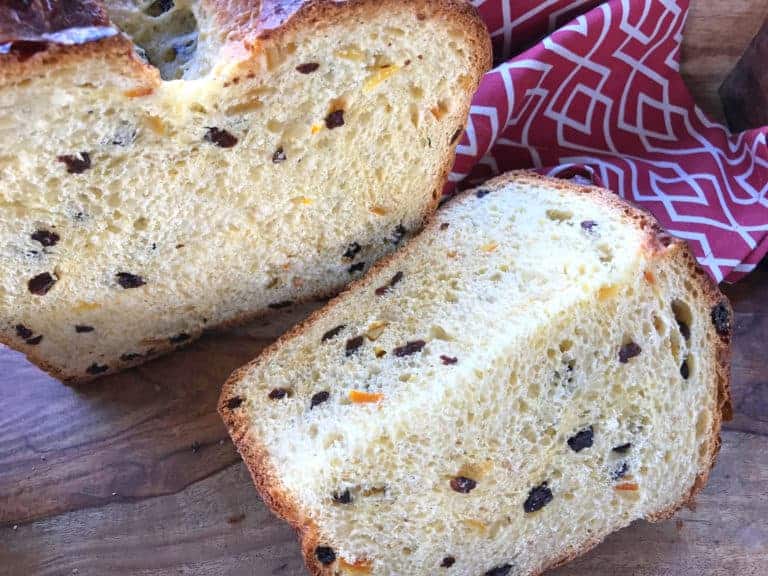
How to Serve Panettone
Traditionally Panettone is served on Christmas Day, on Santo Stefano (December 26th, a national holiday), on New Year’s Eve and New Year’s Day. It’s enjoyed for breakfast, brunch, or after a main meal. Panettone is cut vertically into wedge-shaped slices and traditionally served with tea, coffee or a sweet wine. In some areas of Italy it is served with sweetened mascarpone (crema di mascarpone) or zabaglione. It’s also wonderful sliced, toasted and slathered with butter or served with a vanilla custard sauce or fruit sauce. On a less traditional note, it’s also fabulous cubed and used for making a British-style pudding or trifle or, my favorite, dipped in egg to make Panettone French toast!
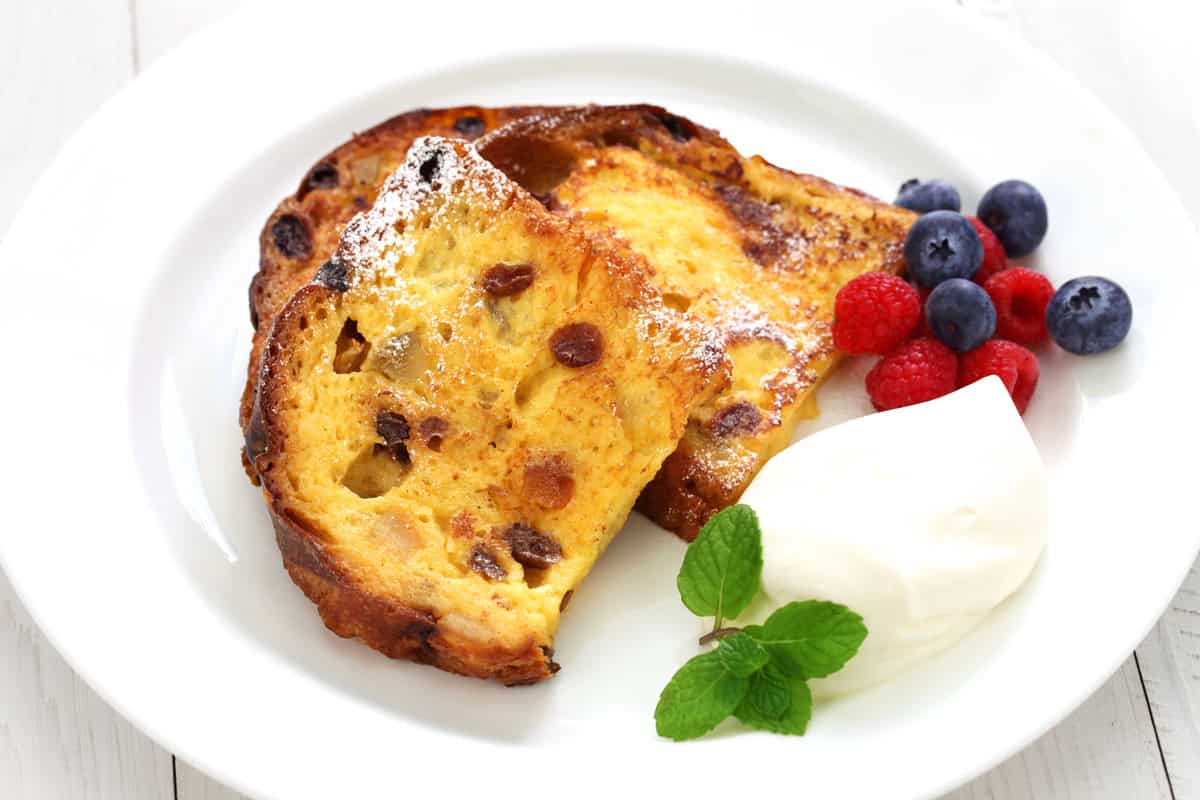
Equipment and Key Ingredients
Paper Panettone Mold: To make panettone you’ll need a traditional paper panettone mold. These are constructed of thick, sturdy paper with a smooth coating inside and are not meant to be reused.
This recipe uses a traditional 7.3″ x 4.25″ panettone mold. These molds are made in Italy and are excellent quality.
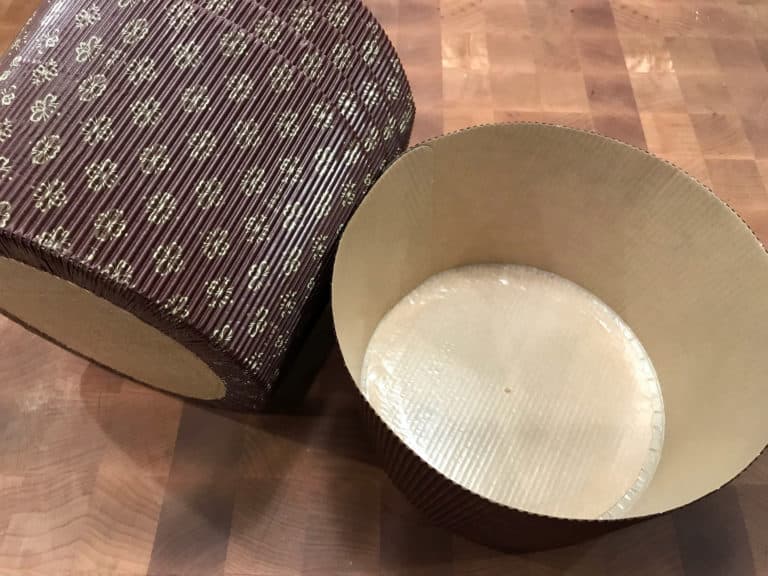
Homemade Candied Orange and Lemon Peel: Please, please, PLEASE do yourself a HUGE favor and leave the store-bought stuff on the shelf. I am not exaggerating when I say that using homemade Candied Orange Peel and Candied Lemon Peel makes ALL THE DIFFERENCE in the flavor of your panettone! It’s easy to make, can be frozen and kept for months, and trust me, you’ll be SO happy you made it!
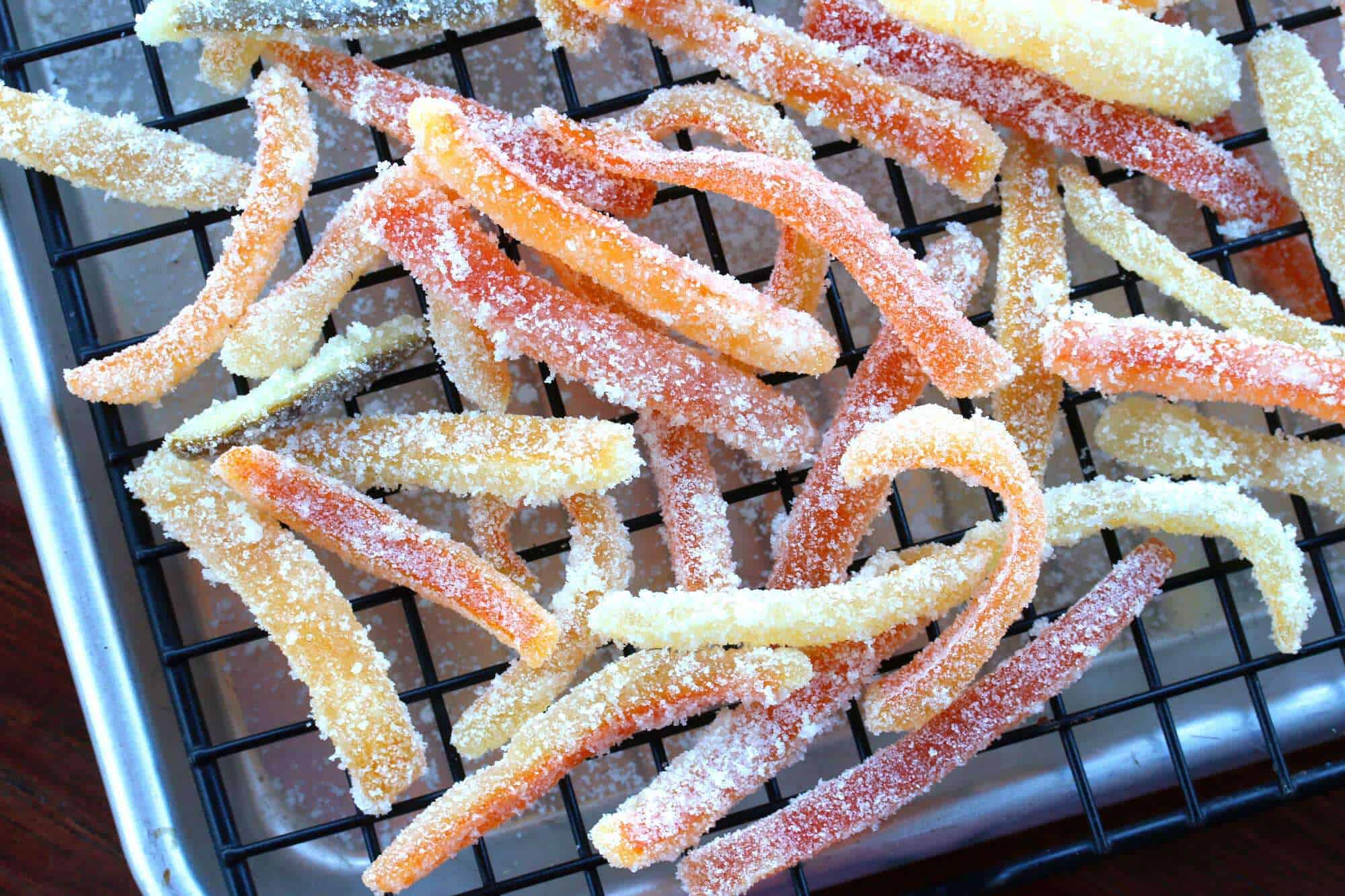
Panettone Recipe
Let’s get started!
Day 1: Make the Starter and Prepare the Dried Fruits
Place the raisins, candied lemon peel, candied orange peel, lemon and orange zest in a small bowl and pour 1/4 of hot water over them. Stir, cover and let soak for at least 2 hours or overnight. Drain any excess liquid before adding it to the panettone dough.
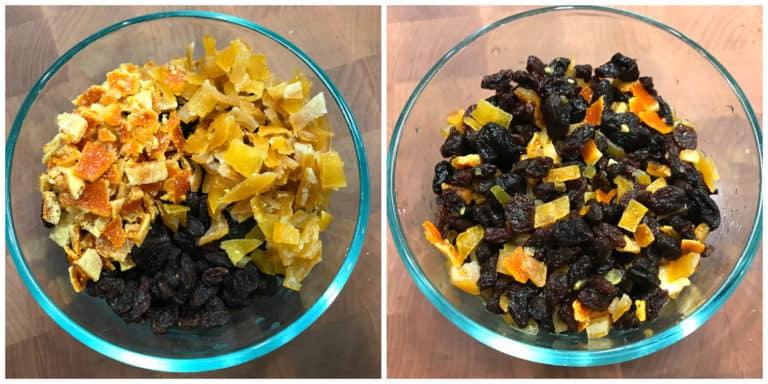
To make the starter, stir the yeast into the lukewarm water and let it sit for about 10 minutes until frothy. Place the flour and salt in the bowl of a stand mixer with the dough hook attachment (if your bowl is too large for that small of quantity knead it by hand). Add the yeast mixture to the flour mixture.
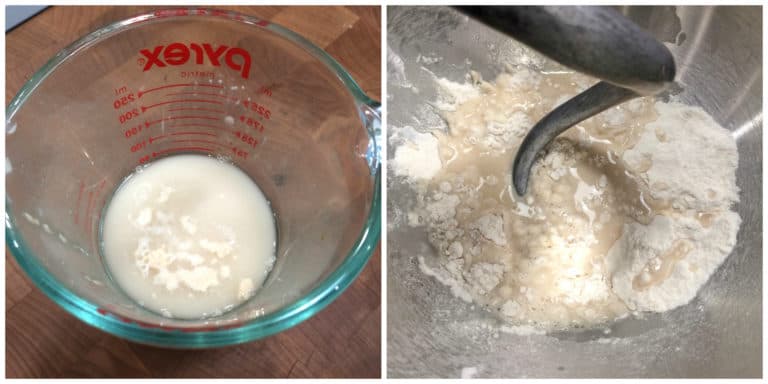
Knead for 5 minutes if using the stand mixer and about 10 minutes if kneading by hand.
Shape the dough into a ball and put it in a very lightly greased bowl, cover loosely with plastic wrap and let it rise at room temperature until doubled in size. Punch it down, cover with plastic wrap again and refrigerate it overnight.

Day 2: Make the Panettone
The next day take it out and let it come to room temperature before proceeding (this will take about 2 hours). Let it rise until nearly doubled in size and then gently punch it down before adding it to the panettone batter.

Place the flour, yeast, salt and sugar in the stand mixer and stir to combine. Attach the dough hook attachment. Add the egg yolks and milk.
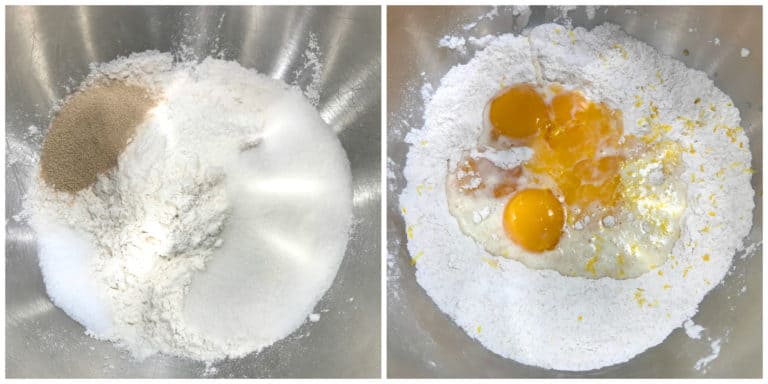
Mix it until it comes all comes together. Punch down the starter dough and add it to the stand mixer.
Knead the mixture for 5 minutes, regularly scraping down the sides.
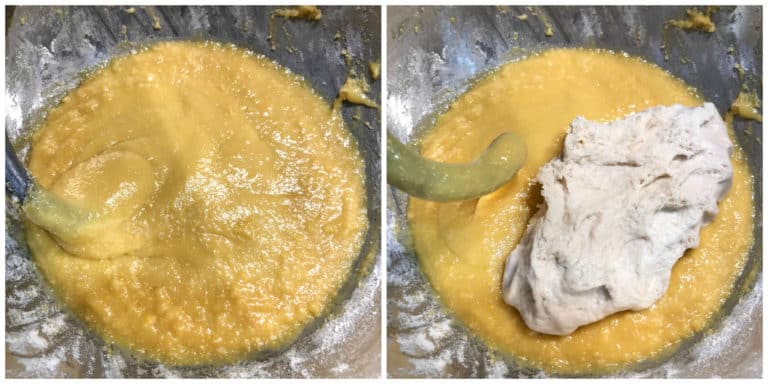
Add the softened butter, vanilla and honey and knead for another 10 minutes. (Yes, that’s 10 minutes.)
The mixture should be totally smooth and elastic but not overly sticky.
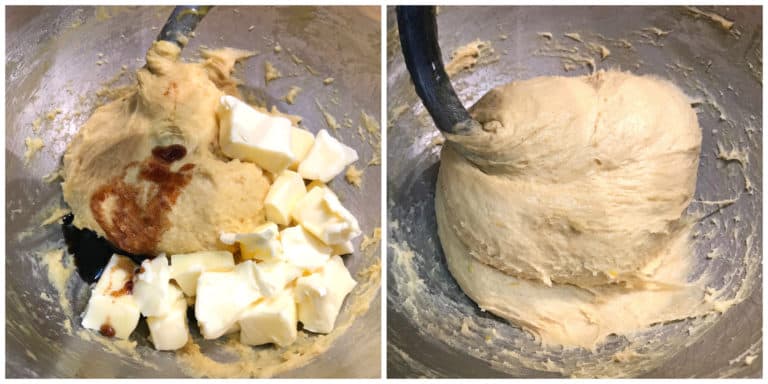
Knead the dough until the fruit is fully incorporated.
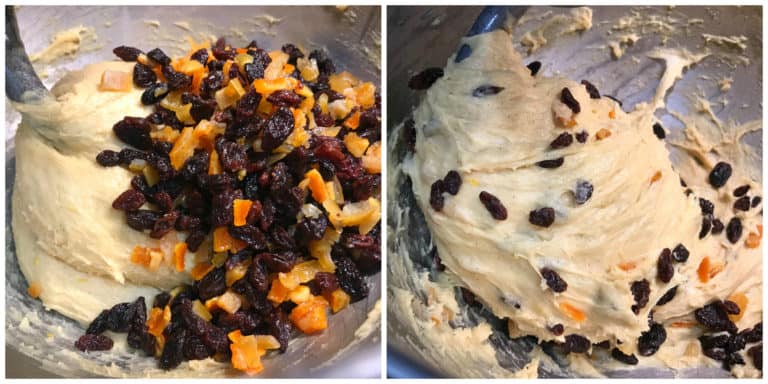
Scrape the dough down, cover the bowl loosely with plastic wrap.
Let it rise at room temperature until nearly tripled in size, about 3 hours.
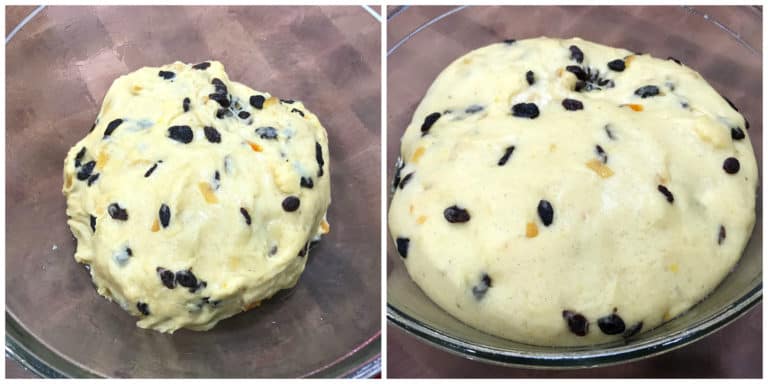
Butter the panettone mold.
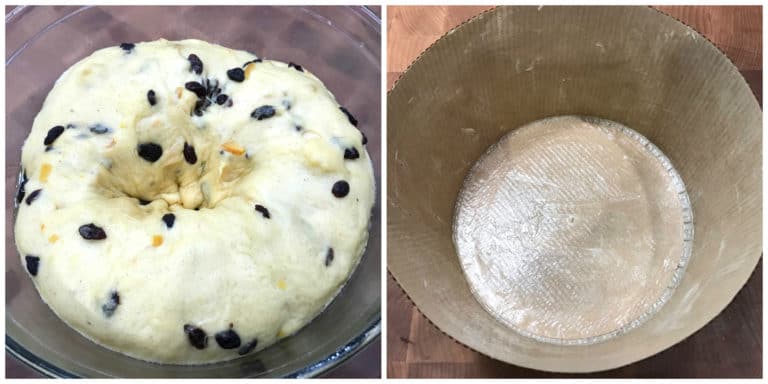
Form the dough into a ball and place it seam side down in the buttered panettone mold.
Cover it loosely with plastic wrap and let it rise for about another 2 hours or until doubled in size. It should be risen to about 1 inch or so higher than the rim of the mold.
Towards the end of this final rise preheat the oven to 350 degrees F (325 if using convection) and place the rack in the lower third of the oven.
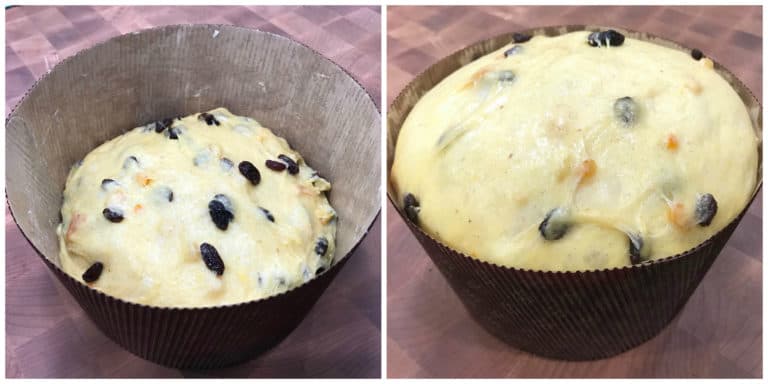
If you’d like a glossy finish on your panettone, lightly beat an egg in small bowl.
Brush the top of the panettone with this egg wash.
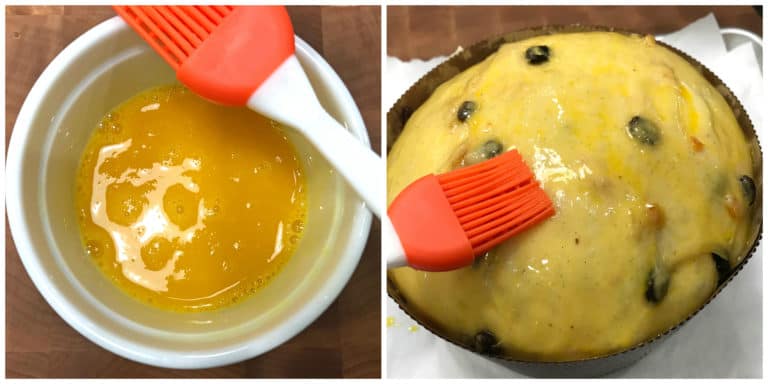
Use a very sharp knife (I use a razor blade) and score an “x” across the entire top of the panettone.
Place about a tablespoon chunk of butter in the center.
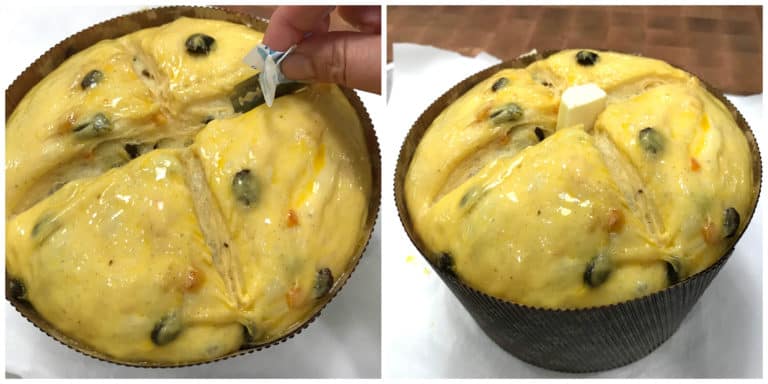
Bake the panettone for 40-60 minutes (this will vary depending on the denseness of the dough) or until a toothpick inserted into the center comes out clean (if the top is browning too quickly place foil over it). Be careful not to over-bake or the panettone will be very dry.
***Recommended: For best accuracy and to prevent under or over-baking, use an instant read thermometer. The panettone is done when the internal temperature reaches between 190 and 195 degrees F.
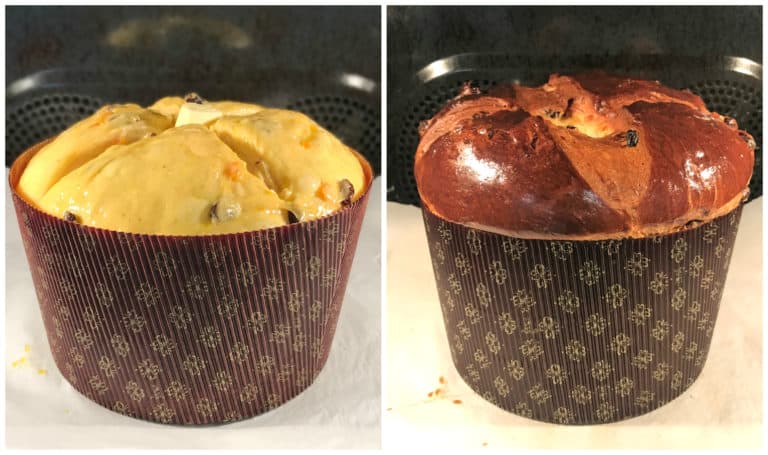
Why Do I Need To Hang Panettone?
When the panettone comes out of the oven it will cave in on itself unless you prevent it. So it is crucial to immediately hang it upside-down. To do this stick two wooden skewers through the bottom of the panettone and hang it upside down in a large pot or somewhere where it is able to remain hanging upside down until it is cooled.
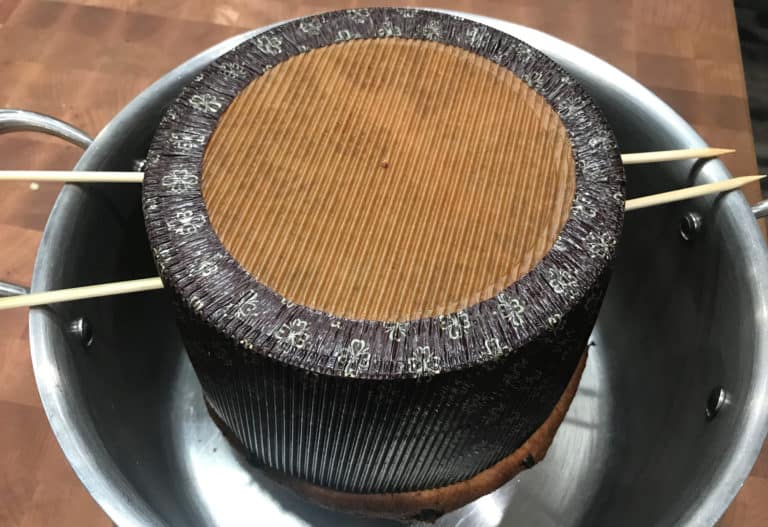
Your panettone is ready to eat! See serving suggestions near the beginning of the post.
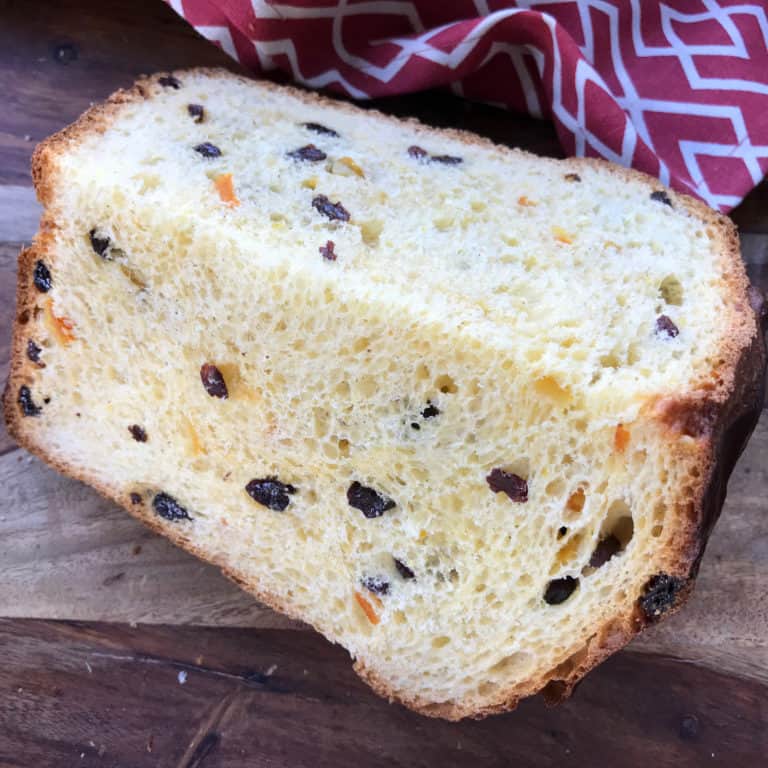
For more traditional Christmas treats be sure to try my:
- Pandoro (Verona Christmas Bread)
- Stollen (German Christmas Bread)
- Pfeffernüsse (German Iced Spiced Cookies)
- Lebkuchen (Nürnberger Elisenlebkuchen)
- Springerle (German Anise Cookies)
- Printen (Aachener Gingerbread)
- Speculoos (Gingerbread Shortcrust Cookies)
- Vanillekipferl (Vanilla Crescent Cookies)
- Zimtsterne (Cinnamon Star Cookies)
- Bethmännchen (Marzipan Cookies)
- Heidesand (Browned Butter Shortbread Cookies)
Save This Recipe
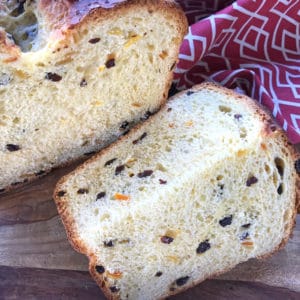
Traditional Panettone Recipe
Equipment
Ingredients
- For the Starter:
- 1/4 cup (60 ml) lukewarm water
- 1/2 teaspoon (2 g) active dry yeast
- 3/4 cup (100 g) all-purpose flour
- 1/2 teaspoon (2 g) salt
- For the Fruit Mixture:
- 1 cup (140 g) raisins
- 1/4 cup candied orange peel
- 1/4 cup candied lemon peel
- OR Homemade Candied Orange & Lemon Peel *VERY STRONGLY RECOMMENDED (using homemade makes ALL the difference in flavor! It's easy to make and you'll be SO glad you did!)
- zest of one lemon
- 2 teaspoons fresh orange zest
- For the Panettone:
- 2 1/2 cups (350 g) all-purpose flour
- 3 teaspoons active dry yeast (9 g)
- 1/2 teaspoons (2 g) salt
- 1/2 cup (100 g) granulated sugar
- 1/2 cup (130 ml) milk , at room temperature (do NOT use cold milk)
- 5 large egg yolks , at room temperature (do NOT use cold eggs)
- prepared starter (see above)
- 10 tablespoons (150 g) unsalted butter , at room temperature (do NOT use cold butter)
- 2-3 tablespoons honey
- 1 tablespoon quality vanilla bean paste (recommended for best flavor but can substitute 2 teaspoons pure vanilla extract)
- OR one vanilla bean, scraped
- 1 lightly beaten egg
Instructions
- For the Starter: Stir the yeast into the lukewarm water and let it sit for about 10 minutes until frothy. Place the flour and salt in the bowl of a stand mixer with the dough hook attachment (if your bowl is too large for that small of quantity knead it by hand). Add the yeast mixture to the flour mixture and knead for 5 minutes if using the stand mixer and about 10 minutes if kneading by hand. Shape the dough into a ball and put it in a very lightly greased bowl, cover loosely with plastic wrap and let it rise at room temperature until doubled in size. Punch it down, cover with plastic wrap again and refrigerate it overnight. The next day take it out and let it come to room temperature before proceeding (this will take about 2 hours). Let it rise until nearly doubled in size.
- To Prepare the Fruit Mixture: Place the raisins, candied lemon peel, candied orange peel, lemon and orange zest in a small bowl and pour 1/4 cup of hot water over them. Stir, cover and let soak for at least 2 hours or overnight. Drain any excess liquid before adding it to the panettone dough. Properly draining it is critical to preventing a wet dough.
- To Prepare the Panettone: Place the flour, yeast, salt and sugar in the stand mixer and stir to combine. Attach the dough hook attachment. Add the egg yolks and milk and mix until it comes all comes together. Punch down the starter dough and add it to the stand mixer. Knead it for 5 minutes, regularly scraping down the sides. Add the softened butter, vanilla and honey and knead for another 10 minutes (yes, that's 10 minutes). The mixture should be totally smooth and elastic but not overly sticky. Add the fruit mixture and knead until fully incorporated. If the dough is too wet add a little extra flour. Scrape the dough down, cover the bowl loosely with plastic wrap and let it rise at room temperature until nearly tripled in size, about 3 hours. Towards the end of this final rise preheat the oven to 350 degrees F (325 if using convection) and place the rack in the lower third of the oven.
- Gently punch down the dough, form it into a ball and place it in a buttered panettone mold (7.3" x 4.25", click link for reference). Cover it loosely with plastic wrap and let it rise for about another 2 hours or until doubled in size. It should be risen to about 1 inch or so higher than the rim of the mold. Once the panettone is risen, if you'd like a glossy top brush the top of the panettone with some egg wash (a lightly beaten egg).
- Use a very sharp knife (I use a razor blade) and score an "x" across the entire top of the panettone. Place about a tablespoon chunk of butter in the center. Bake the panettone for 40-60 minutes or until a toothpick inserted into the center comes out clean (if the top is browning too quickly place foil over it). Be careful not to over-bake or the panettone will be very dry.Recommended: For best accuracy and to prevent under or over-baking use an instant read thermometer. The panettone is done when the internal temperature reaches between 190 and 195 degrees F.
- Remove the panettone from the oven and immediately stick two wooden skewers through the bottom of it and hang it upside down inside of a large, deep pot or somewhere where it can hang as it cools. This will prevent the top of the panettone from collapsing in on itself. Once cool, slice the panettone vertically in slices. Enjoy at room temp or toasted. See blog post for serving recommendations. Stored tightly wrapped in plastic wrap it will keep at room temperature for a few days to up to a week. It is best eaten within 2-3 days.
Nutrition
Originally published on The Daring Gourmet November 12, 2019



















This looks incredible. Will be making it soon. I have a dietary restriction, can this be made with olive oil instead?
Hi Mags, yes you can but use a little less; I would use about 7 1/2 tablespoons of oil.
Great recipe. It’s my first time making panettone and It’s better than the one I ordered from Italy! I wanted a very lemony version so I replaced raisin with more homemade candy lemon and also put the lemon and Orange rind directly in the dough vs hot water. I also warmed the milk a bit to help activate the yeast. The instant read thermometer really helped during the baking process. I do have one question: do you put the panettone mold directly on the rack or on a sheet pan? Thanks for the recipe!
Wonderful, Arlene, thank you so much! I place mine on a sheet pan just to help stabilize it but it isn’t necessary.
Hello
I have made this panettone but it didnt bake well i didn’t use the panettone paper mold i used an actual panettone pan. I left it for 75 minutes but the center did not bake.
The flavor was amazing,want to make it again but afraid it will happen again….maybe should of left it for 1hour and half…what went wrong??
Hi Orsola, I’ve only the traditional paper molds so I’m not sure. But as noted in the recipe the safest bet to ensure the center is done is to use a thermometer – that way you don’t have to try and guess and risk ruining your special creation.
Has anyone tried the recipe yet? Can the starter be left out of the fridge overnight?
Hi Rita, keeping the starter in the fridge overnight will ensure that it has a slow and gradual rise. If it’s left out at room temperature that long it will rise more quickly and then deflate, resulting in over-proofing.
I’d love to give it a try! Looks SO good!
I have always wanted to make this bread! What a great recipe.
I am loving this panettone recipe. I had this when we were visiting Italy and I fell in love. I am going to make this and I bet it is just as good.
OH my, this sounds incredible!! Its my favorite bread during the holidays!!! YUM!
I LOVE that you made a homemade version of panettone! My husband LOVES it and he will eat it with zabaglione on it too!
I am excited to try this!! Looks so fluffy & I love all the ingredients. Sounds refreshing!
I love this bread – I can’t imagine a holiday season without it.
I love bread of all kinds!! This is a wonderful, soft bread & I love that you can add whatever you like inside or leave plain.
I love eating this during the holidays! I never know the name and we aren’t Italian but maybe my dad picked this up when he lived in Europe? This is going to be wonderful to gift my dad!
Love this! Perfectly flavored and so light and fluffy! Delish!
Pue genius, and looks so delicious!